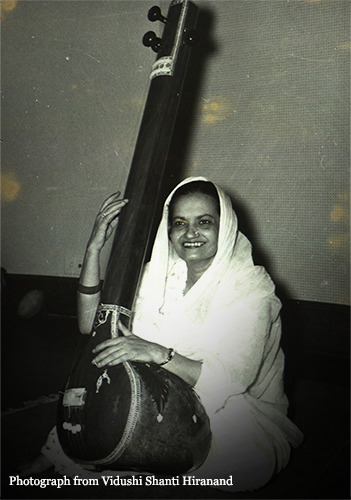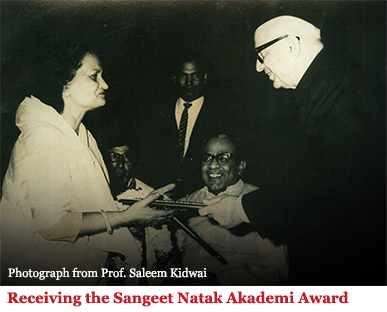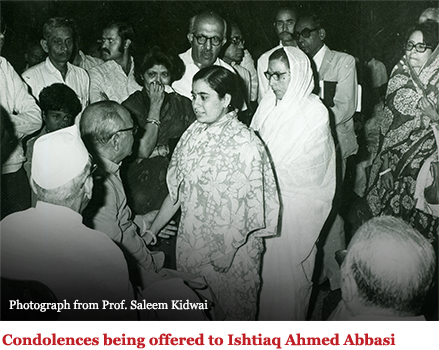Birth & childhood
Though there are a few variations in the details of accounts speaking of Akhtaribai Faizabadi’s birth & early childhood, there is however a predominant narrative.
Akhtari was born on October 7, 1914 – one of a set of fraternal twins – the girls were called Akhtari and Anwari. However, Anwari lost her life very early on – just shy of turning three years old. The cause of death is not clear and it is said that Akhtari never spoke about this particular incident. Their mother, Mushtari Begum was a well known courtesan in Lucknow, though it is believed that she wasn’t as gifted a singer as her daughter. The girls’ father was Asghar Hussain who belonged to a well-respected, affluent & aristrocratic family of Lucknow and was a lawyer by profession. It is well-known that Akhtari had little or no contact with him and was raised entirely by her mother. Mushtari Begum left Lucknow for Faizabad shortly before the birth of her daughters. It is indicated that this move might not have been entirely of Mushtari Begum’s own accord and that she might have been pressured or threatened by her patron’s – Akhtari’s father’s – family into fleeing.
Akhtari grew up in Gulabbari, Faizabad and was fondly called Bibbi at home. She was quite a mischievous child and there are several annecdotes to illustrate this. One of them is narrated by her senior-most disciple, Shanti Hiranand:
One day she came back from school and refused to ever go back again. When her mother questioned her, it turned out that she had cut off her teacher Miss Bahadur’s plait and was genuinely frightened to go back to face her ire. When her mother wanted to know why she had done so, she said that since her teacher looked so beautiful with her long plait that Ammi wanted it for herself and so she simply cut it!
Akhtari had a keen interest in music even as a child. Mushtari Begum, or Bade sahib as she was fondly known, fortunately noticed this inclination and decided to train her daughter and hone her raw talent.
Initiation into music
As a child, Akhtari was very curious and fascinated by music. She is said to have relished attending music functions in her neighbourhood, and always insisted to be taken to watch the nautanki when it visited her town. She also loved to sing and would be eager to perform with ease for anyone who would listen. A large part of the credit for Akhtari’s success goes to her mother who made all efforts to ensure that her daughter was trained by the very best while she was still a young girl.
At the age of about seven or eight years, Akhtari started receiving her initial ta’lim by the Sarangi maestro Ustad Imdad Khan, who happened to be the Sarangi accompanist of singers like Mallika Janof Agra and Gauhar Jan of Calcutta. He started her training with the nuanced and difficult raga Kamod as opposed to the norm of beginning with rudimentary & basic ragas. Akhtari later reminisced that her lessons began with the bandish “Hoon toh tan man chhandu…”. Whether it was due to the tough and serious beginning or the child’s playful nature which was tiresome, the Ustad could not teach her beyond six months.
Mushtari Begum then moved to Gaya along with Akhtari, but they continued to visit Faizabad often. On one such visit, Ustad Sakhawat Hussain Khan, who was himself a well know Sarod player, suggested that Akhtari train under Ustad Ata Mohammed Khan of the Patiala gharana. As was the practise in those days, the Ustad and shagird would live under the same roof and train for hours on end. Once Khan sahib heard Akhtari sing, he willingly agreed to teach her and even took the decision to move to Mushtari and Akhtari’s home.
Akhtari was then introduced to a basic knowledge of khayal gayaki. It is said that Khan sahib would be relentless in ensuring that Akhtari practised her vocal exercises and scales and that her riyaz in those days was intense, overlooked of course by Mushtari Begum. Khan sahib soon realised that Akhtari’s heart was not in the khayal training, though she was competent in the genre. The meticulous and often rigid genre of classical singing seemed to hold her back. He suggested to Mushtari Begum that her daughter was probably more interested in the deeply emotional styles of thumri, dadra and ghazal gayaki and proceeded to train her in those.
Early performances & acting career
Around the late 1920s or early 30s, along with Khan sahib, Mushtari Begum and Akhtari moved to Calcutta to explore professional opportunities for Akhtari’s talent. She performed in public for the first time in Calcutta.
A music festival was organised to raise funds for the victims of the Bihar earthquake at the Alfred Theatre in Calcutta in 1934. None of the major artists scheduled to perform that day could make it and the crowd was getting anxious. Khan sahib is believed to have suggested that his young student perform till further arrangements could be made. But Akhtari enthralled one and all and the event became a solo concert of four ghazals and five dadras. It is said that Akhtari received compliments from Sarojini Naidu that evening, who happened to be in the audience.
Akhtari proceeded to sing and act on stage at the Corinthian theatre in Calcutta as a part of a theatre company. There is a debate as to whether Rangmahal was her first professional production or the musical Nai Dulhan.
Akhtari had a significant film career – she featured in the capacity of a singing actor in films like Ek Din Ka Badshah (1933), Nal Damayanti (1933), Mumtaz Begum (1934), Ameena (1935), Naseeb Ka Chakkar (1935) and Jawani Ka Nasha (1935) along with playing the lead in Mehboob Khan’s Roti (1942). She also contributed in films like Dana Pani (1953) & Ehsaan (1954) as a playback singer. Even though she had stopped appearing on screen by then, the legendary Satyajit Ray managed to convince her to play a cameo in Jalsaghar (1958).
However, this sudden rise in her stage and screen career meant that she could often not give enough time to her riyaz. It is around this time that it is believed that her tutelage under Ustad Ata Mohammed Khan came to an end.
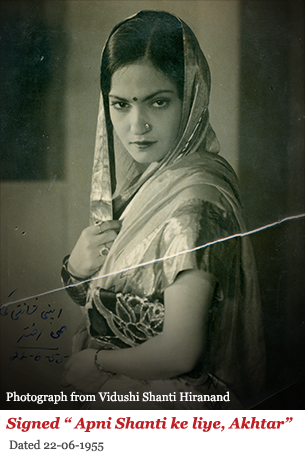
Rise to stardom

After the move to Calcutta, the financial condition of the family is said to have bordered on the precarious. Akhtari was eager for her career to take off not only on a professional level but also to be able to help the situation. Ustad Ata Mohammed Khan is believed to have thought that Akhtari may not have been ready to be a professional recording artist yet. However, against all advise she signed a record deal.
The Megaphone Company signed her on and she started recording professionally as early as 1933. Her initial recordings did not create a stir and upon several tries, her seventh 78rpm record was released in 1938 which had the now famous ghazal “Deewana banana hai toh deewana bana de…” The ghazal was an instantaneous success and officially her first “hit”. Akhtaribai Faizabadi became a sensation right away and was now a celebrity.
Shanti Hiranand recounts a charming story about this particular ghazal:
A Pir baba asked her to open her book of couplets and place her finger on any ghazal. It happened to be “Deewana banana hai toh deewana bana de…”, one of Behzad Lucknawi’s works, prophysing that she would make a name for herself if she sang it. And that single ghazal made her a household name in northern India.
There are accounts of fans that literally were crazy about her after listening to this ghazal. It is said that one man in Lucknow was so mesmerized by her that he covered the walls in front of her house (in Lucknow) stretching the entire street with the words Hai Akhtari written repeatedly with a piece of charcoal.
Akhtaribai Faizabadi continued to sing for commercial records and her name spread rapidly across the country.
Second phase of ta’lim & relationship with patrons
Towards the end of the 1930s, Akhtari returned to her training in music and quite abruptly ended her sojourn with films. It is believed that at a music conference in erstwhile Bombay, among stalwarts of classical music like Gauhar Jaan from Lahore and Zohra Jaan Ambalewali, Akhtari realised that she lacked the tayyari and finesse of a trained voice. She started training earnestly again under Ustad Abdul Wahid Khan of the Kirana gharana. Akhtari’s style is believed to be a product of a combination of the influences of her two Ustads – Ustad Ata Muhammad Khan of the Patiala gharana and Ustad Abdul Wahid Khan of the Kirana gharana.
Around the same time Akhtari was also invited to the court of the Nizam of Hyderabad and the Nawab of Rampur, apart from the courts of the Maharajas of Darbhanga and Kashmir. Moazzam Jah from Hyderabad invited Akhtari often to his court for special occasions and was also known to hand over couplets to her and request that she set a composition to the words and sing for him. It is said that Akhtari never disappointed her audience.
The most talked about association was with the Nawab of Rampur, Raza Ali Khan, a connoisseur of literature and music. He was believed to be smitten by Akhtari and had invited her to stay in Rampur for a long period of time, which she did. He even tried to convince her to stay in his court permanently. Akhtari, however found it difficult to be bound to one place and sing for only one audience, and left Rampur without informing anyone.

Begum Akhtar
Marriage with Ishtiaq Ahmed Abbasi
In 1944, she married a barrister from an aristocratic family of Lucknow, Ishtiaq Ahmed Abbasi. Initially living in Mateen Manzil, they found their home in Havelock Road. The colourful description of the home by Shanti Hiranand is reminiscent of that era. After her marriage, Begum Akhtar is said to have been confined in the walls of domesticity for a brief period as she stopped performing. This is said to be attributed to Abbasi sahib’s initial reluctance in letting Akhtar perform publically. There are conflicting accounts of this period. Ollikkala quotes an interview of Begum Akhtar, conducted by Sandhya Sen where she voices her agony.
“I gave up everything for him but he could not give up even a little for me; I was not allowed to perform in any program or gathering—I was almost not allowed to sing at all I can’t forget the pain of those terrible days. For a year and a half even the radio was a distant thought.”
Despite the pain of not being able to sing, people close to her (Vidushi Shanti Hiranand, Vidushi Anjali Banerjee, Prof. Saleem Kidwai, Ms. Saeeda Raza & others) say that the marriage was a happy and successful one where the social role played by Begum Akhtar seamlessly merged with Abbasi sahib’s life. The couple loved to host parties & entertain guests from every walk of life. Even though marriage brought with it certain confines of domestic life, it also brought the respectability which Begum Akhtar craved for. Given time, along with her charming and generous nature, she became a favourite amongst the men & women of Lucknow’s elite class. Saleem Kidwai says, “She travelled at will. He did not interfere in her career or the space she created outside the home. In honest gratitude, she returned lavish attention on him.”
Radio & the return to performing career
In 1948, Begum Akhtar recorded an hour and a half session at the All India Radio, Lucknow. This was probably made possible because of the involvement of Sunil Bose, who was the station director of AIR Lucknow at that time. Radio proved to be the medium which provided initial anonymity and a respectable platform to perform. The patronage shifted in this period from the Nawabs to the government and AIR played a crucial role in promotion of artists. In the post independence era, in the process of proclaiming a national identity, it became radio’s mandate to promote the national culture. In AIR’s universal grading system of musical excellence she was awarded A grade, the highest level offered for light classical musicians. Thus, through AIR Lucknow & Delhi, she was able to return to the world of music and her voice spread to the entire nation.
Performances at AIR also led to invitation to perform at various musical conferences across the country bringing Begum Akhtar back into limelight. The first major public performance was held in Delhi at Shankar Lal Festival in the year 1951; the same year as passing away of Mushtari Bai. Infact, many claim that Mushtari Bai’s passing away was a crucial reason for Abassi sahib to allow Akhtar resume to her music fully. It is believed by many that grief of losing her mother drove Begum Akhtar to extreme physical and emotional pain. Many suggested that the remedy would be to resume singing as emotional outlet. Infact, Sushila Misra reports a conversation with Abbasi sahib: “After her marriage, she had given up singing. But when her mother died, she became so hysterical with grief that she used to sit and weep endlessly at her mother’s grave. I was most worried. Our good family-friend and physician advised me that unless I permit her to resume her singing and thus provide her with an emotional outlet, she might become mentally deranged with sorrow. So I had to agree.”
Important concerts & recordings
After returning to the performance stage, there was an almost immediate revival of her popularity as an artist. From the early 1960s until her death in 1974, Akhtar toured constantly, singing in newly-established concert halls in major centres throughout the country. Every year, she would perform at 4-5 major concerts across the country. The ‘musical conferences’ were institutionalized post independence as a part of the mandate to integrate classical music to respectable middle class life. The offers to perform in such programmes came pouring in and soon she was performing in the country widely. As S. Kalidas points out, she created a “small cosmopolitan islands for herself in Delhi, Bombay and Calcutta, where she would be the unquestioned mistress of her fawning audience, away from the disapproving eyes of staid and narrow minded Shiite Lucknow.” The only time she performed publically in Lucknow was at an all women charity concert.
In 1961, she was invited to perform in All Bengal Music Conference which has been noted as one of her most memorable performances. In the same year, she also toured Pakistan on special invitation of the Indian High Commission and presented a Republic Day recital in Karachi. In 1963, she travelled to Afghanistan where the King rewarded her lavishly. In 1967, she also travelled to Soviet Union to perform. She had also done an impromptu recording in Mecca when she decided to visit there, almost on a whim. Since she had no money on her she sang a na’t at a crowded spot, where, once being recognized, she was invited to record for the local radio station. Performing at Ghalib’s centenary celebrations in 1969 was one of the most crucial concerts for Begum Akhtar where she released a long playing record of Ghalib’s ghazals.
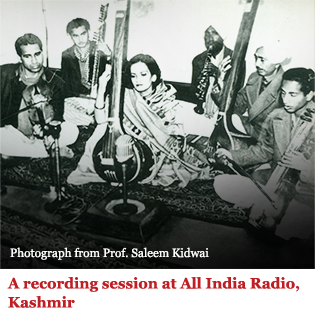
Contemporaries & poets
A well respected musician, Begum Akhtar had good relationships with musicians and poets of the time. She was a close friend of another courtesan singer Rasoolan Bai, who as per her account, “remained a Bai all her life.” Siddheshwari Devi was another contemporary of hers. In an interesting comparison, Sheila Dhar points out “Rasoolan Bai was like vintage brandy – deep & mellow. Siddheshwari Devi was like a bird of paradise who threw her heart & soul into heaven with much energy and passion. Begum Akhtar’s technique was much subtler; you never associated her music with effort. It was something effortlessly stated with great sophistication and restraint.”
Ustad Bade Ghulam Ali Khan, Ustad Amir Khan, Ustad Hafiz Ali Khan, Ustad Vilayat Khan were some of the musicians who visited Begum Akhtar and Shanti Hiranand remembers serving food and refreshments during such visits. Pandit Kumar Gandharva would also visit her every time he was in Lucknow. In an interview with Acharya K. C. D. Brahaspati, Begum Akhtar said that Ustad Faiyaz Khan and Ustad Bade Ghulam Ali Khan’s music was so powerful that it could bring tears even to the eyes of most devout Hindu or Muslim, thus demonstrating her own deep appreciation of their art.
Behzad Lucknawi was one of the poets closest to Begum Akhtar, to the extent that he wrote poetry with her in mind. His poem “Deewana banana hai toh deewana bana de…” was instrumental in Begum Akhtar’s initial popularity. Some contemporary poets and past masters of the ghazal form, including Ghalib, Mir, Jigar, Faiz, Kaifi, Shakeel, Shamim and Dagh were among Begum Akhtar’s favourites. She was also close to Firaq Gorakhpuri and Saleem Kidwai recounts an incident where she visited him in a hotel in Daryaganj and presented him with the recording of previous night’s mehfil where she had performed his ghazals. Many close to Begum Akhtar ascribe the refinement in her taste of poetry to her husband, Abbasi sahib. Shanti Hiranand recalls evenings after evenings where Begum Akhtar, Abbasi sahib & his friends would recite one ghazal after another. It is believed that Abbasi sahib played a crucial role in her nuanced understanding of Urdu poetry.
Saleem Kidwai ascribes a crucial role Begum Akhtar played in the milieu of Urdu literature. He says, “By this time she had become an arbiter and transmitter of Urdu poetry, adding to the glory of prominent poets and launching unknown poets to fame. She kept in touch with the work of the major poets and knew many of them as close friends. She gave the ghazal an extrordinary new lease of life and her enormous contribution in keeping Urdu at the mainstream of Hindustani culture is yet to be fully appreciated.”
Students & disciples
Begum Akhtar was fondly called Ammi by most of her disciples. She began accepting students formally only after she settled in her home in Lucknow. Vidushi Shanti Hiranand is one of the first disciples and has spent most amount of time with Begum Akhtar. Born to a business family in Lucknow, she started her training at the music college before moving to Karachi. Due to partition her family moved back to Lucknow where she started her training under Begum Akhtar in 1951. She practically lived with Begum Akhtar for almost 10 years, about which Hiranand talks of in detail in her book. She would be a part of everyday household chores and was almost treated like a daughter at the Abbasi home. Anjali Banerjee became her student in 1954, few years after Shanti Hiranand. Either of the two would also accompany Begum Akhtar for the outstation concerts, providing vocal support, the concerts thus becoming a learning opportunity for them. Her later students prominently include Rita Ganguly and Rekha Surya. She never charged fee for teaching and taught in accordance with the guru-shishya parampara. She also held a position at Bhatkhande College of Music in Lucknow but, according to many, could not fulfil this role as she was not suited for this kind of a teaching responsibility. But as a teacher she held nothing back from her students. She was generous with her teaching and believed in giving all she could to them. Infact, Ollikaka points out that every student has a positive outlook towards Begum Akhtar, which is a unique legacy in itself.
Awards & recognition
Begum Akhtar has been considered the undisputable Malika-e-Ghazal (Queen of Ghazal) due to her contribution in bringing ghazal gayaki to its present form. The recognition of her musical finesse came from not only her enchanted audience but also from the state. In 1968, she was awarded Padma Shri by the Indian Government which is the fourth highest civilian award. She was also presented the distinguished-artist award by the Sangeet Natak Akademi in 1972. Posthumously, in 1975, she was conferred with Padma Bhushan which is the third highest civilian award.
She has been termed as a national treasure more than once. It was not only the musical contribution but the culture in which her life was woven in, has been considered representation of an era in itself. The remains of the courtesan roots in her life and singing gave the glimpse of this dying tradition. Shiela Dhar believes that she represented synthesis of Indian folk roots. She poignantly says,
“The joys, sorrows and aspirations of simple folk constitute the emotional raw material she works with; her music echoes with the airs and accents that have risen from the soil of this country for countless centuries. This material filters through the exquisite musical culture and passionate lyricism of her personality and is transformed into a highly sophisticated sound structure of permanent and classic beauty. Through Begum Akhtar’s music, millions of people have been led unawares to an understanding of Indian classical music and Urdu poetry which they on their own would never have thought of acquiring. She has blessed both Indian music and the ghazal with long life and carried the best in our culture into the homes and hearts of the humblest and most unschooled among us.”
Demise
During the last few months of her life, it is said that Begum Akhtar had a premonition of her approaching death. In her final recording for All India Radio she performed a famous ghazal by Kaifi Azmi that begins with a couplet:
Mein dhundhta hun jise, woh yahan nahi milta
And during her last private house concert in Delhi she sang:
Muhabbat karne waale kam na honge
Teri mehfil mein lekin hum na honge
After performing at a concert in Ahmadabad on 30th October 1974, Begum Akhtar suffered a heart attack and passed away at the age of 60. She died doing what she loved, singing beautifully for an enthralled audience. She had selected her final resting place long ago, in the beautiful mango orchard at Pasand Bagh, next to her mother’s grave. Her husband, Abbasi sahib, along with many admirers and disciples, bade her last farewell. Her epitah reads ‘Begum Ishtiaq Ahmed Abbasi’.
Since her passing away, a great deal of dialogue has emerged about her. In some narratives she appears to be a talented but tormented woman, shaped by the male patriarchal society. Other narratives portray her as successful transformation from bai to begum in order to keep practicing her art. But one thing which cannot be denied to Begum Akhtar is the agency with which she led her life, whether it was her personal life or her art. Humble, yet unapologetic seemed her attitude towards life. She has deeply impacted lives of many through her soulful music, which still reverberates through the nation.
Legacy
The legacy of Begum Akhtar is alive, even over 40 years after her demise. In 2005, her senior most disciple, Shanti Hiranand, wrote Begum Akhtar: Story of My Ammi, a tribute to her guru. Another book, Aye Mohobbat: Reminiscing Begum Akhtar, by her disciple Rita Ganguly was published in 2008. S Kalidas, an eminent art critic, made a documentary, Hai Aktari in 1994 and wrote a book, Begum Akhtar: Love’s Own Voice in 2009.
In 2012, Shanti Hiranand, Saleem Kidwai and others, along with the efforts of Sanatkada, Lucknow, through a grant from the Ministry of Culture, helped restore the gravesite of Begum Akhtar which had fallen into a condition of neglect. Shanti Hiranand paid musical homage to her guru at the renovated gravesite in 2012, Prof. Shruti Sadolikar-Katkar in 2013 and Vidushi Shubha Mudgal in 2014.
The year 2014-15 was declared as the official year of Begum Akhtar Centenary commemoration. Since the declaration of the centenary year, various institutions such as Sangeet Natak Akademi, National Centre for Performing Arts and others have held events in different parts of the country. The Indira Gandhi National Centre for the Arts, in collaboration with NaadSagar Archives & Documentation Society for South Asian Music, has held commemorative festivals in Hyderabad, Bhopal and Lucknow along with launching this web portal on life, work & legacy of Begum Akhtar.
“Woh jo hum mein tum mein qarar tha…”, as Begum sahiba sings Momin, reminds us of the pining her voice created, which still resonates in hearts of her listeners. Her connection with the listeners is a legacy that would perhaps never be forgotten.
